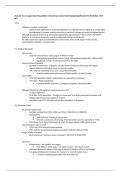How far do you agree that the position of American women had changed significantly for the better, 1917-
80?
Intro:
- Political, economic, social gains
o political most significant as achieved legislation on important issues/rights (e.g. voting rights,
contraception), changes actually enforced in practice & change occurred throughout period
- although all aspects limited (e.g. increased employment opportunities = often simply short-term
response to economic demands), overall considerable change across period
- by 1980, many new rights & improvements vs 1917 (vote, more work, larger variety of jobs,
contraception, abortion, increased SoL)
P1: Political/legal gains
- right to vote
o 1920 19th Amendment, 1920 League of Women Voters
Although few poor/black women voted, still significant proportion, still had right
Significant, voting = fundamental democratic right
- Discrimination & equality
o Kennedy’s Commission of Enquiry into the Status of Women influenced 1964 Equal
Opportunities Act (included clause on sexual equality)
o 1967 Johnson extended AA to cover sexual discrimination
Ensured employment gains were of higher quality, de facto change
- Social rights
o 1972 SC Eisenstadt v Baird (contraception to married & unmarried)
o 1973 Roe v Wade (abortions)
Increased bodily autonomy, changed perceptions, increased rights
- Although limitations still significant improvement vs 1917
o no equal rights act
o STOP ERA 1972 opposition – though can argue was an activist group led by women, still
limited improvement to position of women
o USA didn’t sign 1979 UN policy of non-discrimination in all aspects
P2: Economic Gains
- Increased employment
o Number working from 1910-1940 went from 7,000,000 to 13,000,000
o During WW2
1940 Selective Training & Service Act
Women’s Land Army of America reformed (3mil women in agriculture 1943)
o 1933 Camp Tera, Elanor Roosevelt 1936, 36 camps taking 5,000 women a year
- Married women able to work
o 1940, only 16% married women worked
o 1941 Lanham Act extended childcare provision (130,000 children 1944)
- Range of jobs increased
o Black women on nursing courses increased 1,100 1939 to 2,600 1945
- However…
o Employment = low quality, low wages
Post-WW2, $ white man = 61c white woman = 23c black woman
o Women’s Bureau of Labour (1920) largely ignored, failed to achieve real change
o Can argue employment = temporary measure to meet demands of war
½ women working during WW2 left work after war




